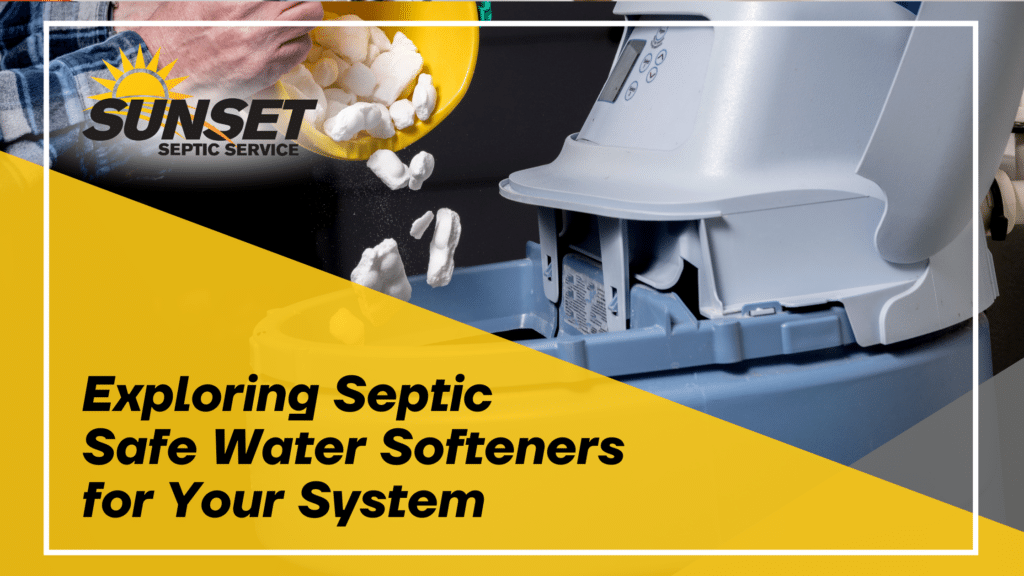As a homeowner, you’ve likely experienced the frustrations of hard water. The excess calcium and magnesium can cause scale buildup in your pipes and appliances, making them less efficient and shortening their lifespan. Hard water also reduces the effectiveness of soap, leaving behind scum and dingy clothes. While water softeners are the go-to solution for transforming hard water into soft water, ensuring your system is using a septic safe water softener is crucial to prevent problems with your septic system.
Why You Need a Septic Safe Water Softener
If your home has a septic system, choosing a septic safe water softener is crucial to maintaining the balance of your tank. Traditional water softeners use sodium chloride during the softening process. Unfortunately, the extra sodium introduced into your septic system can disrupt the bacteria responsible for breaking down waste. Without these bacteria, your septic system’s functionality can become compromised, leading to inefficiency and potentially costly repairs. Opting for a septic-safe water softener, such as a salt-free system or one with demand-initiated regeneration, can significantly reduce the risk of these problems.
How Water Softeners Can Affect Septic Systems
Water softeners work through a process called ion exchange, which removes calcium and magnesium from the water and replaces them with sodium ions. This process produces a byproduct called backwash, which contains the sodium, magnesium, and calcium removed during softening. When this backwash enters your septic system, it can interfere with the anaerobic bacteria needed to break down waste and maintain a balanced pH.
Over time, the extra sodium can cause a variety of problems, including:
- Reduced Bacterial Activity: The elevated sodium levels can inhibit the growth and effectiveness of septic bacteria.
- Hydraulic Overload: The excess water from backwash can overwhelm the system, reducing its efficiency.
- Concrete Tank Damage: Sodium chloride can corrode the concrete used in many septic tanks, causing deterioration.
- Soil Swelling in Drain Fields: The sodium can cause swelling in clay-heavy soils, leading to reduced drainage in your drain field.
Running a Septic-Safe Water Softener on Your Property
There are several steps you can take to minimize the negative impact of your water softener on your septic system:
- Upgrade to a Modern Softener: Newer models are designed to use less salt during the ion exchange process, reducing the amount of sodium that enters your septic tank. Consider salt-free systems or softeners that use demand-initiated regeneration to minimize backwash and sodium discharge.
- Use Potassium Chloride Instead of Sodium Chloride: Potassium chloride is more expensive but is a safer alternative for septic systems, as it has less impact on bacterial activity and soil hydraulic conductivity.
- Set the Softener to Regenerate Based on Water Flow: Adjusting the system to regenerate only when necessary, based on your household’s water usage, reduces unnecessary backwash.
- Soften Only the Necessary Water: If possible, only soften the water inside your home and allow water used for outdoor purposes to remain as-is.
- Consult a Septic Professional: Your septic provider can offer valuable advice on adjusting your system to handle the additional load from water softeners while maintaining optimal efficiency.
Maintaining Your Septic Safe Water Softener System
Regular maintenance is crucial to ensure the longevity and optimal performance of your septic-safe water softener. Effective maintenance includes:
- Periodic inspections of both the softener and the septic system
- Pumping the septic tank as needed
- Using septic-safe additives to maintain a healthy bacterial balance
By proactively addressing any potential issues, you can prevent costly repairs and ensure your system operates efficiently for years to come.
Environmental and Economic Benefits
Choosing a septic-safe water softener offers several benefits beyond just protecting your septic system. These systems are designed to minimize environmental impact by reducing sodium discharge into the environment and conserving water through efficient regeneration. Additionally, you can avoid costly repairs and replacements by preventing damage to your septic system, saving you money in the long run.
The Key to a Long-Lasting, Septic-Safe Water Softener System
Choosing a septic-safe water softener is essential for homeowners who rely on septic systems. You can protect your septic tank from potential damage by selecting the right softener, minimizing sodium output, and consulting with professionals. A few thoughtful changes can prevent costly repairs and keep your septic system running efficiently.
Remember, the health of your septic system depends on finding the right balance between water softening and septic safety. With the proper measures in place, you can enjoy the benefits of soft water without compromising the integrity of your septic system. For expert advice or service, contact Sunset Septic—your trusted partner in maintaining a healthy, efficient septic system




